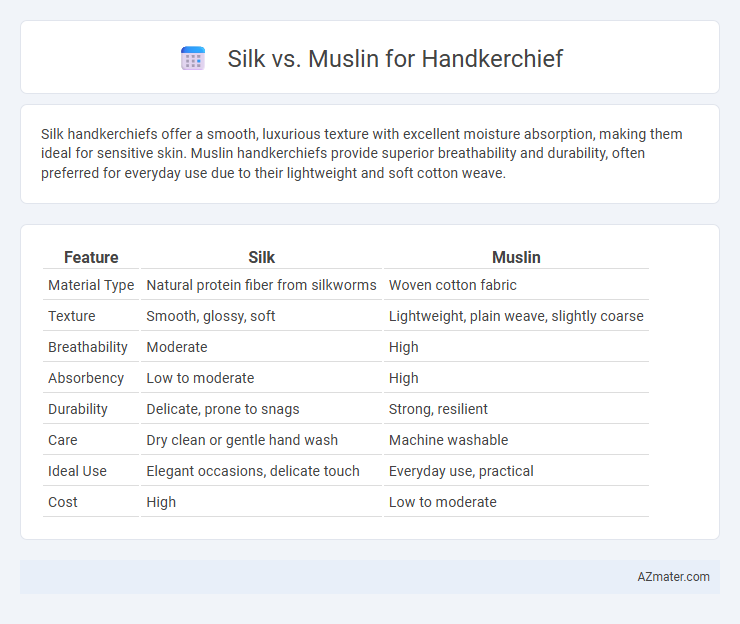Silk handkerchiefs offer a smooth, luxurious texture with excellent moisture absorption, making them ideal for sensitive skin. Muslin handkerchiefs provide superior breathability and durability, often preferred for everyday use due to their lightweight and soft cotton weave.
Table of Comparison
| Feature | Silk | Muslin |
|---|---|---|
| Material Type | Natural protein fiber from silkworms | Woven cotton fabric |
| Texture | Smooth, glossy, soft | Lightweight, plain weave, slightly coarse |
| Breathability | Moderate | High |
| Absorbency | Low to moderate | High |
| Durability | Delicate, prone to snags | Strong, resilient |
| Care | Dry clean or gentle hand wash | Machine washable |
| Ideal Use | Elegant occasions, delicate touch | Everyday use, practical |
| Cost | High | Low to moderate |
Introduction to Handkerchief Fabrics
Handkerchief fabrics like silk and muslin serve distinct purposes based on their texture, durability, and breathability. Silk offers a smooth, luxurious feel with natural hypoallergenic properties, making it ideal for sensitive skin and elegant use. Muslin, a lightweight and breathable cotton fabric, provides excellent absorbency and a soft touch suitable for everyday practicality.
What is Silk?
Silk is a natural protein fiber produced by silkworms, known for its smooth texture, high tensile strength, and natural sheen, making it ideal for luxurious handkerchiefs. Its hypoallergenic properties and excellent moisture-wicking ability provide comfort and durability in delicate fabrics. Compared to muslin, silk offers superior softness and elegance, often preferred in premium handkerchiefs for its lightweight and breathable qualities.
What is Muslin?
Muslin is a lightweight, finely woven cotton fabric known for its soft texture and breathability, making it a popular choice for handkerchiefs. Unlike silk, muslin is highly absorbent and easy to wash, offering durability and comfort in everyday use. Its natural, hypoallergenic properties provide a gentle touch suitable for sensitive skin.
Comparison of Texture and Feel
Silk handkerchiefs offer a smooth, luxurious texture with a natural sheen that feels soft and gentle against the skin, ideal for delicate use. Muslin handkerchiefs, made from loosely woven cotton, provide a matte finish with a lightweight, breathable feel that is slightly rougher but highly absorbent. Choosing between silk and muslin depends on preference for silky smoothness versus breathable practicality.
Durability and Longevity
Silk handkerchiefs boast a luxurious texture but tend to be less durable due to their delicate fibers, which can easily weaken with frequent washing and exposure to sunlight. Muslin, made from tightly woven cotton, offers superior durability and longevity, maintaining its integrity even after repeated use and washes. Choosing muslin handkerchiefs ensures a longer-lasting, practical option while silk prioritizes elegance over resilience.
Absorbency: Silk vs Muslin
Muslin handkerchiefs excel in absorbency due to their loosely woven cotton fibers, which efficiently soak up moisture, making them ideal for sweat or tears. Silk handkerchiefs, while known for their smooth texture and elegance, have lower absorbency because silk fibers repel water, reducing moisture retention. For practical use requiring high absorption, muslin offers superior performance compared to silk.
Style and Aesthetic Appeal
Silk handkerchiefs offer a luxurious sheen and smooth texture that elevate any outfit with elegance and sophistication, making them ideal for formal occasions or stylish accessories. Muslin handkerchiefs provide a soft, matte finish with a delicate, rustic charm that complements casual or vintage-inspired looks. The subtle drape of silk contrasts with the breathable, lightweight fabric of muslin, allowing for versatile styling options based on personal aesthetic preferences.
Care and Maintenance
Silk handkerchiefs require gentle hand washing with mild detergent and should be air-dried away from direct sunlight to preserve their delicate fibers and sheen. Muslin handkerchiefs are more durable, allowing for machine washing on a gentle cycle, but should be tumble-dried on low heat or air-dried to prevent shrinkage. Both fabrics benefit from careful handling to maintain softness and longevity, with silk demanding more meticulous care due to its natural protein fibers.
Eco-Friendliness and Sustainability
Muslin handkerchiefs, made from loosely woven cotton, offer high biodegradability and lower environmental impact due to cotton's renewable nature and minimal chemical usage in organic farming. Silk handkerchiefs, sourced from silkworms, provide durability and reusability but involve intensive water consumption and ethical concerns related to sericulture. Choosing muslin supports eco-friendly practices through sustainable cultivation and easier recycling, while silk demands careful consideration of resource intensity and animal welfare.
Choosing the Right Fabric for Your Handkerchief
Silk handkerchiefs offer a smooth, luxurious texture with high durability and a natural sheen, making them ideal for formal occasions or delicate skin. Muslin, a lightweight, breathable cotton fabric, provides excellent absorbency and softness, suitable for everyday use and sensitive skin. Choosing the right fabric depends on whether you prioritize elegance and smoothness with silk or practicality and comfort with muslin.

Infographic: Silk vs Muslin for Handkerchief
 azmater.com
azmater.com